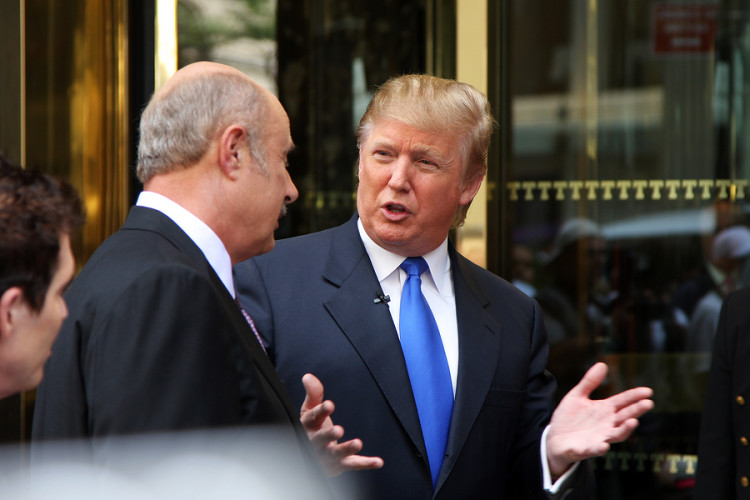Trump’s Tax Plan Is Still Unclear on How He’d End Up Paying More

©2015 Bloomberg News
Margaret Collins
(Bloomberg) — Though Donald Trump devotes an entire chapter of his just-published book “Crippled America” to his tax proposal, it remains difficult to see how it will have a detrimental effect on the Republican presidential candidate’s bottom line—as he has often claimed while pitching the plan in speeches and media appearances.
“I will probably end up paying more money,” he told CNN in late September, “but at the same I think the economy will do better, so I’ll make it up that way.”
In the book, which will be released Tuesday but which Bloomberg Politics obtained at a Washington, D.C. bookstore last week, Trump says his plan is to simplify the U.S. tax code so it no longer takes too much money from people who need it most, while letting others use loopholes to reduce their burden.
“The proposed policies will allow the middle class to keep most of their deductions while eliminating many of the deductions for the very rich,” Trump writes.
Nonetheless, his plan would help top earners when it comes to wages. It sets the top income tax rate at 25 percent, compared to the current 39.6 percent. But there are breaks for low-income earners under the Trump plan: Married couples making less than $50,000 wouldn’t owe any taxes under his plan.
While Trump says he would eliminate deductions that lower people’s taxable income, he’d keep two of those most loved by high earners: write offs for mortgage interest and charitable donations. That may represent a bow to political reality from the billionaire businessman who likes to tout his determination to defy Washington’s laws of gravity.
https://twitter.com/realDonaldTrump/status/”Trump considers himself the political outsider, but that’s actually the most politically palatable or feasible move,” said Tony Nitti, a partner at accounting firm WithumSmith+Brown. Trying to eliminate breaks for mortgage interest paid or charitable donations has been insurmountable because of massive lobbying support behind them, he said.
An estimated 6 million tax filers who made more than $200,000 in 2014 claimed the mortgage interest deduction, saving them about $29 billion in taxes, according to figures by the Joint Committee on Taxation. That same group saved about $28 billion through the deduction for charitable contributions.
The two other major deductions are those for state and local taxes, and real estate taxes paid. They would presumably disappear under Trump’s plan—although he doesn’t say so on his website or in his new book.
Trump says he’d eliminate other credits, deductions and exemptions in the code, but doesn’t specify which ones, or whether he’d target breaks such as tax-deferrals on savings in 401(k), IRA and similar retirement accounts.
“The problem with all these plans is they are loosely specified,” said Roberton Williams, a senior fellow at the nonpartisan Urban-Brookings Tax Policy Center, speaking generally of tax proposals from the 2016 presidential contenders. “The details aren’t all there and you don’t really know what they would do.”
In its analysis of candidates’ tax plans, the Tax Policy Center says that Trump’s proposal will likely cost the U.S. Treasury money, but that it’s impossible to say how much. Another Washington-based research group, the Tax Foundation, estimates that Trump’s plan would reduce federal revenue more than $10 trillion over 10 years.
Another Trump proposal with impact that’s hard to gauge: His plan would make it harder for high-income taxpayers to fully benefit from personal exemptions and deductions by steepening the eligibility curve for provisions of the tax code known as Pep and Pease. In 2013, Congress reinstated these limits for married couples with adjusted gross income of more than $300,000 a year or $250,000 for singles.
Though Trump doesn’t spell out how much of a change he’d make to the Pep and Pease provisions, Williams said it would likely raise tax rates on high-income households. That’s because while they’d still get some benefit from the remaining deductions such as mortgage interest and charitable deductions, those breaks wouldn’t be worth as much as they are now, he said.
How much Trump’s plan would benefit or hurt him directly remains unclear. The real estate mogul, who tweeted a photo of himself signing his mammoth tax return on October 15—the due date for taxpayers who received extensions—has yet to disclose his 2014 tax return to the public.
Trump’s campaign spokeswoman, Hope Hicks, didn’t respond to multiple e-mails asking when her boss plans to release his return. Though there is no legal requirement to do so, it has become traditional for the president and vice president, along with candidates for the White House, to make their tax returns public. So far, 2016 candidates who have done so are: Jeb Bush, Hillary Clinton, and Carly Fiorina.
Nitti said that a big drop in income-tax rates like the one Trump proposes will benefit the wealthy more than they could ever be penalized by the elimination of itemized deductions.
And Trump would eliminate the estate tax—another plus for wealthier Americans like him. The candidate himself is a trustee of multiple family trusts set up by his father to pass wealth onto heirs, according tothe candidate’s July financial disclosures. That change could simplify the tax code because there would be less incentive to use its complex trust provisions and rules on valuing assets to lower the tax bite at death.
“The current code is crazy,” Trump says in his new book. His goal, he writes, is to reduce the complexity and “put H&R Block out of business.”
It’s a catchy quote, but the reality is that Trump would still need approval from Congress to achieve a tax-code overhaul. And while many lawmakers agree with the concept of simplifying the tax code they haven’t been able to reach a deal on how to do that.
To contact the author of this story: Margaret Collins inNew York at mcollins45@bloomberg.net To contact the editor responsible for this story: Kathy Kiely at kkiely9@bloomberg.net







No Comment